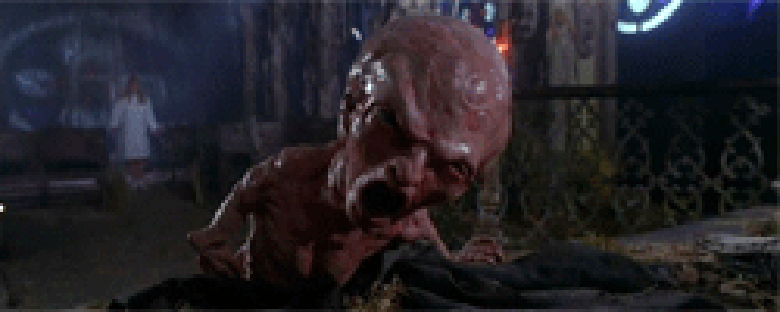Reviews
Stephen Hopkins
USA, 1989
Credits
Review by Adam Balz
Posted on 30 October 2006
Source New Line DVD
Related articles
Features: 31 Days of Horror
Features: Neverending Nightmares: A Retrospective of Friday the 13th and A Nightmare on Elm Street
It’s a boy!
Having lost her friends to Freddy Krueger in Part 4, Alice is now preparing to graduate. Hoping to leave for Europe with her boyfriend Dan, Alice hasn’t seen Krueger since purging him of his victims. Unfortunately, Krueger has decided to revisit the teenage residents of Springwood, and he does so through the dreams of Alice’s unborn child.
While Krueger’s methods of torture are wonderfully repulsive and uniquely ironic — an aspiring supermodel being force-fed her own entrails, a comic-book geek transformed into cardboard and then bled of color — director Stephen Hopkins’ attempts at sustaining the franchise stumble along without any clear destination. Freddy Krueger’s intention to be “born back into the real world” is, to say the least, outlandish; viewed in conjunction with Freddy’s Dead, Part 5 marks the beginning of a large inconsistency. The M.C. Escher finale is creative, employing what could be the most adequate symbol for the complexities of dreams, but seeing as how Part 5 was released three years after Labyrinth, the scene reeks of imitation. And as always, the actors are at the mercy of a poorly-written script, with Robert Englund trudging through another volume of trite one-liners.
Additionally, the distinction between dream and flashback is never made clear. We assume Alice is dreaming, but the subtle, unexplored connections made between her and Amanda Krueger hint at a strange manipulation of anamnesis. The introduction of Jacob as Alice’s unborn child at ten years is simply unbelievable, as he acts as both Alice’s guide and Freddy’s unknowing accomplice. Luckily, Hopkins skillfully avoids staining the film with a political message as Amanda Krueger, having just given birth to the bastard Freddy in one of Alice’s pseudo-dreams, recognizes at once that the newborn must be destroyed, even as the hospital staff attempt to dissuade her. (Our patience is spared, albeit slightly, when baby Freddy scampers from the delivery room.)
What Hopkins can’t avoid, however, is the foreseeable cheapening of the story, which forces you into anticipating the worst. At any moment you expect soap-opera drama over the paternity of Alice’s child. You expect Jacob to offer his mother the customary advice, then fade into nothingness. You hope for Amanda Krueger to become Mommie Dearest and subdue Freddy for good. Instead, we’re offered a small, fleeting scene in which mother reabsorbs son, only to have Freddy’s hand burst from his mother’s womb in what could only be described as his rebirth. And, if that wasn’t blatant enough, we’re offered a small gathering of children, all dressed in white, singing:
One, two, Freddy’s coming for you;
Three, four, better lock your door;
Five, six, grab your crucifix;
Seven, eight, better stay up late;
Nine, ten, he’s back again.
Yes, Freddy will be back. But we already knew that, didn’t we?
We don’t do comments anymore, but you may contact us here or find us on Twitter or Facebook.



